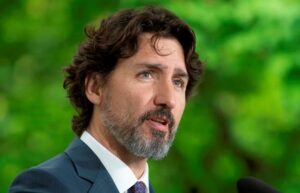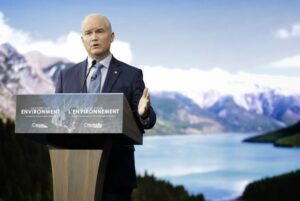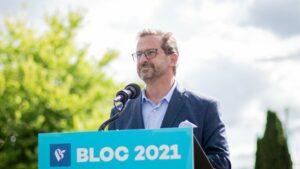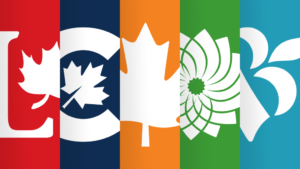This summer, Canada has experienced some of the hottest temperatures in its recorded history, with wildfires in British Columbia and Ontario and devastating drought across the country. One way or the other we’re all impacted by climate change. It’s a critical time to help the environment and the economy recover — and the federal government plays a major role in steering resources in the right direction. The upcoming federal election provides Canadians with an opportunity to confirm or change the course of climate action.
Environics Analytics recently analyzed all 338 Canada’s federal electoral districts and found environmental issues are important to a great number of Canadians. The data indicates that a party’s environmental strategy could help influence its results in at least nine ridings where races were close in the last election. The survey corresponds to a searchable map by Esri Canada that reveals which riding has the most or least ecological concern, according to this poll.
Another recent poll indicates that the majority of Canadians are willing to pay to put a stop to the climate crisis. There seems to be momentum for dedicating more resources to help achieve Canada’s emission-reduction targets. The poll, conducted by Nanos Research, found that 27 per cent of Canadians are willing and 27 per cent are somewhat willing to pay more in taxes or to pay more for things like the price of gas to help the country achieve its emissions-reduction targets.
Will these Canadians step up and vote for climate action? We’ll find out for sure on September 20th. In the meantime, here’s an overview of the key climate strategies of the main federal parties – the Liberals, Conservatives, NDP, the Greens and the Bloc Québécois – and some informed perspective from Canadian climate action experts.
Liberals: A Cleaner, Greener Future
“Climate change is the greatest long term threat of our time, but it is also our greatest economic opportunity.”

Prime Minister Justin Trudeau, leader of Liberal Party of Canada. Image credit: Liberal Party of Canada.
A re-elected Liberal government would move forward with its plan to accelerate climate action for more jobs, cleaner communities and less pollution. Prime Minister Justin Trudeau has vowed to bring national greenhouse gas (GHG) emissions 40 to 45 per cent below 2005 levels by the end of the decade, and to make sure Canada is a net-zero country by 2050. These targets will be supported by the Canadian Net-Zero Emissions Accountability Act. The party also plans to gradually increase the carbon tax to $170 per tonne by 2030. A Healthy Environment and a Healthy Economy plan, supported by an initial $15 billion in investments, aims to build a stronger and cleaner economy and introduces a timeframe for carbon pricing.
Critics argue that the continued use of nuclear power enables the ongoing production of toxic waste, and the small modular reactor (SMR) technology won’t be built until 2026 to 2030, which many say is too late to address the climate crisis. Some also take issue with his support of the Trans Mountain oil pipeline.
Conservatives: Securing the Environment
“Rebuilding Canada’s economic and environmental health is the cornerstone of our approach to combat climate change and secure the future for all Canadians.”
Erin O’Toole, leader of the Conservative Party of Canada. Image Credit: Conservative Party of Canada, via Twitter.
The Conservative’s platform on environment includes four key pillars: introduce low carbon savings accounts; invest in more zero emission vehicles; lower emissions and meet 2030 Paris Targets; and, stand up to major foreign polluters with carbon border tariffs. The Conservative party would adjust carbon pricing to $20 per tonne and increase to $50 per tonne. The Conservatives have also proposed a low-carbon fuel standard that would reduce the carbon intensity of transport fuels, and incentivize environmental protection of agricultural lands and managed forests.
Critics point out that the emissions reductions targets and carbon pricing are lower than the current targets and pricing, and there are ongoing debates within the party over climate change science.
NDP: Ready for Better
“We know that reaching net-zero by 2050 means taking action now, during the term of this next Parliament.”

Jagmeet Singh, leader of the New Democratic Party of Canada. Image credit: NDP
The New Democratic Party’s plan on climate action would set a target of reducing Canada’s emissions by at least 50 per cent from 2005 levels by 2030. The party would create a climate accountability office, to provide independent oversight of federal climate progress, to engage the public, and to make recommendations on how to achieve goals. The party has plans for a net-zero electricity generation and carbon dioxide emissions of 50 per cent below 2005 levels. The party also vows to end all subsidies for oil, gas and pipeline projects, retrofit all buildings by 2050 and strengthen environmental protection. Carbon pricing would be similar with the current system, but the NDP system would require companies to pay tax on a larger portion of emissions.
Unlike the Liberals and Conservatives, the NDP does not support plans to fund nuclear energy, and instead supports the development of energy storage solutions to roll out support for renewables on a larger scale.
Critics point out that while the NDP opposes the Trans Mountain oil pipeline and expansion project, Singh has expressed support for the Coastal GasLink LNG pipeline.
Green Party: A Green Future
“We have the chance of a lifetime to simultaneously tackle the climate crisis while simultaneously building a prosperous and sustainable economy for Canada.”

Annamie Paul, leader of the Green Party of Canada. Image credit: Green Party of Canada.
Climate change is the focal point of the Green’s platform which would double the resolve to reduce GHG emissions. The key steps the Greens would take to transition to a net-zero economy include: achieving net zero emissions as quickly as possible by ensuring a reduction in GHG emissions of 60 per cent from 2005 levels by 2030; ending the extraction of fossil fuels, starting with the Trans Mountain project; replacing every high paying fossil fuel sector job with a high paying green sector job; and, enacting a carbon budget that determines the cumulative amount of GHG that Canada can emit to do its part to keep warming to 1.5 degrees Celsius.
The Greens would accelerate the increase in carbon taxes; beginning in 2022 and up to 2030, increase carbon taxes by $25 per tonne each year. Plans go one step further than the others by promising the development of a national renewable energy electricity grid to ensure that 100 per cent of Canadian electricity is produced from renewable sources by 2030 (and includes no nuclear) and developing pathways for Canada to go carbon negative.
Critics say the plan for 100 per cent of Canada’s electricity to come from renewables by 2030 isn’t realistic since electricity generation is a provincial jurisdiction.
Bloc Québécois: Green Equalization
“Favouring the environment does not mean impoverishing yourself — it’s creating more wealth in a different way.”

Yves-François Blanchet, leader of the Bloc Québécois. Image Credit: Bloc.
The Bloc Quebecois platform calls for the acceleration of Canada’s net-zero timeline from 2050 to 2030. It would also end government support for fossil fuel production and introduce a “climate test” to which all new federal projects would have to pass. Other promises of the environmental platform include: to reject every new project related to the transportation of oil across provinces; to introduce new net-zero emission law to force automakers to carry a minimum amount of electric vehicles (EVs) in their fleet to make them accessible to consumers; to move 100 per cent of the federal vehicle fleet to net-zero emission vehicles; to oppose any new nuclear projects, including new reactors; and to put an end to the Trans Mountain pipeline and oppose any future oil sand project.
Critics point out that the platform does not specify any emissions reduction targets, nor does it set a specific target for 100 per cent EV sales.

Contemplating the campaign promises
Canadian voters are eager to elect climate sincere politicians but identifying them isn’t easy, especially as each party touts the merits of its own climate plan. All readers are encouraged to do their own research and consult a variety of expert sources.
Mark Jaccard is a non-partisan professor and director of the School of Resource and Environmental Management at Simon Fraser University. He is a member of the Royal Society of Canada and a lead author (climate policy) with the Intergovernmental Panel on Climate Change (IPCC), the world’s leading authority on global climate. In August, the IPCC released its sixth report on the state of the world’s climate, which has been called a code red to take climate action.
Each party in this election has a different emissions reduction target for 2030: the Greens aim for 60 per cent reduction, the Bloc does not specify a target in its platform but environmentalists estimate it at 60 per cent, the NDP with 50 per cent, the Liberals with 40 per cent, and the Conservatives have the lowest target at 30 per cent.
However, as Jaccard explained in his 2020 book, The Citizen’s Guide to Climate Success, “targets alone tell us nothing about climate sincerity.” The targets should be backed up by policies that will achieve the targets, and the policies need to be backed by responsible investments and honest management.
The modelling tool Jaccard uses is called gTech, from Navius Research Inc. It’s a leading model used by governments and research institutes in Canada for estimating the GHG effect of climate policies. The model also calculates the cost of achieving the target in terms of reduced GDP.
In Jaccard’s overall assessment, the Liberals score high relative to the other parties for their performance from 2015 to 2021 as the first federal government to be honest about the necessary policies and their costs.
“They don’t get a perfect score, however, because they upped their target to 40 per cent without simultaneously announcing policies to achieve it,” explains Jaccard. “During this election campaign, they’ve unveiled these policies and they are likely to achieve their target, but they should have made efforts to implement these policies as a minority government before calling an election.”
The Conservatives have a lower target, but they have a policy plan that would achieve it, according to the rigorous testing with gTech. However, Jaccard ranks them lower than Liberals because of the past performance of federal and provincial Conservative governments. With regard to his low scores for the Greens and the NDP, Jaccard explains that “it’s misleading to tell Canadians we can magically eliminate 50 per cent and more of our GHG emissions in just nine years, without enormous cost and disruption, especially for certain workers and regions.” (At press time, Jaccard’s analysis did not include the Bloc’s climate action strategies.)
Jaccard empathizes with climate-concerned Canadians that face a daunting task when voting, so he advises voters to beware the following: politicians who promise big but have not subjected their promises and plans to assessment by independent climate policy modellers; politicians who promise that government spending indicates climate sincerity; politicians who promise that someone else (heavy industry, fossil fuel companies, foreign corporations, automobile companies) because he believes that we will all have pay to decarbonize the economy.
Final stretch efforts
Organizations across Canada are ramping up their messaging in the hopes of being heard by all federal parties.
The Climate Action Network Canada (Can-Rac), which represents the concerns of millions of Canadians, is calling on all parties to provide strong, immediate and concrete climate action in their election platforms.
“This election doesn’t have to be useless. Canadians are feeling the impacts of the climate crisis here and now and the federal government has the tools and the power to respond.” said Caroline Brouillette, Can-Rac’s domestic policy manager. “Parties need to step up their climate commitments and compete on their vision for transforming the Canadian economy to make it safer, fairer, more caring and more resilient for all.”
Can-Rac calls on all parties to: end the expansion of fossil fuel production in Canada and to reject all new and proposed fossil fuel projects currently going through the federal evaluation system; provide an accounting for and commitment to reduce emissions accruing from Canadian fossil fuel exports, which outstrip domestic emissions; make a commitment to an overall spending target of at least two per cent of GDP on climate investments and actions; develop a clean electricity standard that will get Canada to a 100 per cent clean grid by 2035; and more.
Meanwhile, the Federation of Canadian Municipalities (FCM), which represents more than 2,000 municipalities and manages the Green Municipal Fund, is asking for billions of dollars from the federal government to help communities become more resilient and address climate-related disasters.
“We’re showing all federal parties how working with municipalities means creating good jobs, getting housing built, protecting people from floods and wildfires, building out modern transit, closing the rural Internet gap, and engaging Canadians from east to west in the march to net-zero,” said Joanne Vanderheyden, president of FCM.
The FCM is asking for the following:
- $2 billion over three years, followed by at least $1 billion annually starting in 2024-2025, to support disaster mitigation and climate resilience projects for things like wildfire mitigation, drought reduction, flood prevention and restoration of wetlands and shorelines.
- $100 million annually for 10 years to enhance municipal natural infrastructure by, among other things, letting municipalities purchase forests, wetlands and green spaces.
- $500 million over five years to update regional climate modelling and natural hazard maps and to include climate impacts in asset management and infrastructure planning.
A majority of Canadians are clearly committed to a green recovery and to addressing the climate crisis, and we have an incredible opportunity with the upcoming election. Support for climate action has never been greater and most parties are devoted to growing the green economy. So it will be very interesting to see which party will convince voters that they will deliver on effective climate efforts — and which party actually will. Either way, be sure to cast your ballot.

Connie Vitello is editor of
Environment Journal.
Featured image by Nong Vang.








